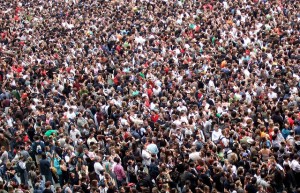
We have this idea that physical crowds are stupid herds. Give them half a chance, and they'll form a stampeding riot mob driven by emotion. Look at history, though, and you'll see many examples of large groups of people being perfectly well-behaved. In fact, in disaster situations, like on 9/11, crowds can even organize themselves in practical ways to help others to safety.
Meanwhile, we tend to talk about virtual crowds — the kind that form online, or between physically distant members of a professional community — as smart. But if that's always true, why do these groups get caught up in financial bubbles and why isn't Twitter a more reliable place to pick up breaking news?
Physical crowds and virtual crowds are different things. But our stereotypes about them stem from a common problem. In both cases, we tend to treat "the crowd" as if it's a distinct entity — as if, at some point, individuals in a group stop being themselves and start to become limbs of a crowd creature. In my latest column for The New York Times magazine, I learned that that's not the way people work in real life. As Clark McPhail, emeritus professor of sociology at the University of Illinois at Urbana-Champaign, told me, "Crowds don't have a central nervous system."
Gustave Le Bon was one of the first people to write about crowds as entities separate from the people in them. His 1895 book, “The Crowd: A Study of the Popular Mind,” shaped academic discussions of human gatherings for half a century and encouraged 20th-century fascist dictators, including Benito Mussolini, to treat crowds as emotional organisms — something to be manipulated and controlled. (Perhaps a Le Bonian understanding of crowds makes us feel more comfortable about the atrocities of the 20th century.) But “The Crowd” was more a work of philosophy than of science, McPhail told me. Le Bon’s ideas were based on armchair analysis of past events, not on carefully documented studies of crowds in action. In the 1960s, sociologists began to study protests and public gatherings, and they realized that the things they believed about crowd behavior didn’t align with what took place in the real world.

No comments:
Post a Comment